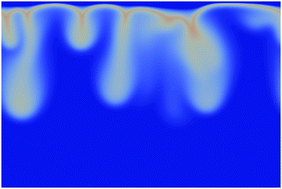Chemically-driven convective dissolution
Abstract
When a solute A dissolves in a host phase with a given solubility, the resulting density stratification is stable towards convection if the density profile increases monotonically along the gravity field. We theoretically and numerically study the convective destabilization by reaction of this dissolution when A reacts with a solute B present in the host phase to produce C via an A + B → C type of reaction. In this reactive case, composition changes can give rise to non-monotonic density profiles with a local maximum. A convective instability can then be triggered locally in the zone where the denser product overlies the less dense bulk solution. First, we perform a linear stability analysis to identify the critical conditions for this reaction-driven convective instability. Second, we perform nonlinear simulations and compare the critical values of the control parameters for the onset of convection in these simulations with those predicted by linear stability analysis. We further show that the asymptotic dissolution flux of A can be increased in the convective regime by increasing the difference ΔRCB = RC − RB between the Rayleigh numbers of the product C and reactant B above a critical value and by increasing the ratio β = B0/A0 between the initial concentration B0 of reactant B and the solubility A0 of A. Our results indicate that chemical reactions can not only initiate convective mixing but can also give rise to large dissolution fluxes, which is advantageous for various geological applications.

- This article is part of the themed collections: PCCP Editor’s Choice, 2020 and 2019 PCCP HOT Articles


 Please wait while we load your content...
Please wait while we load your content...